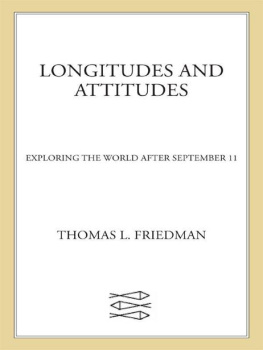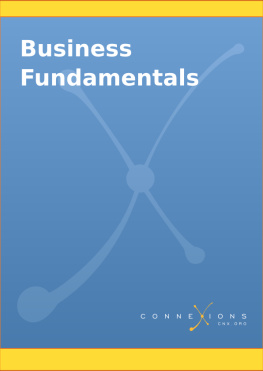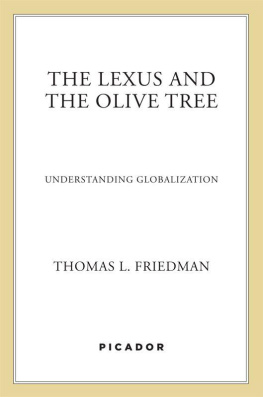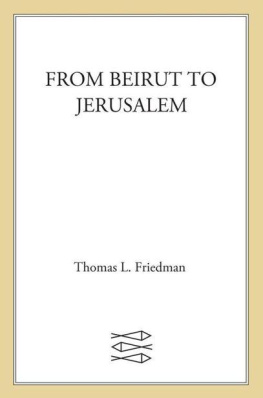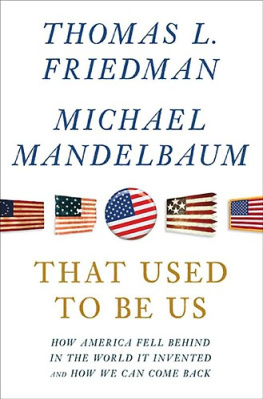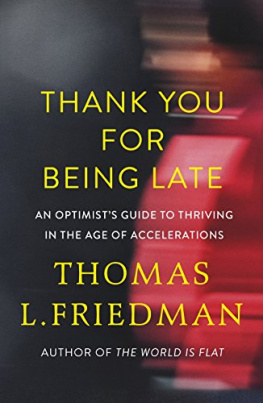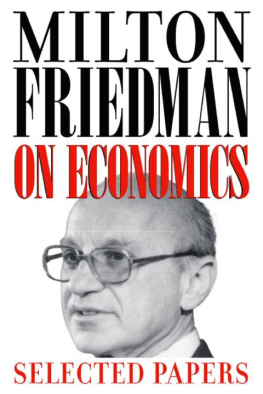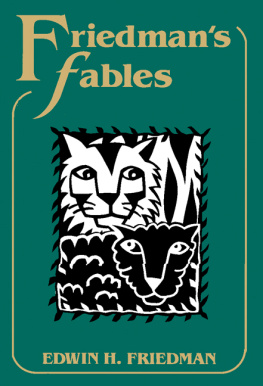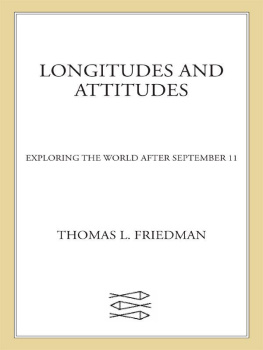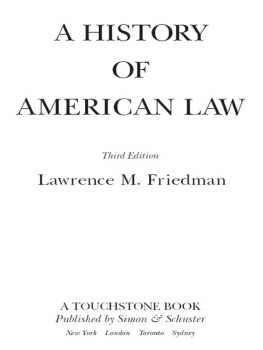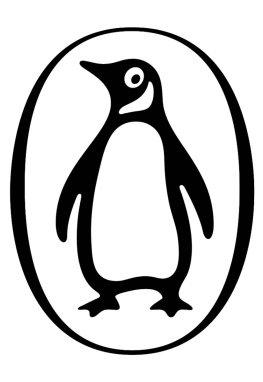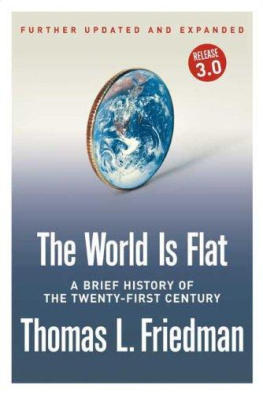ALSO BY THOMAS L. FRIEDMAN
From Beirut to Jerusalem (1989)
The Lexus and the Olive Tree (1999)
LONGITUDES
AND
ATTITUDES
LONGITUDES
AND
ATTITUDES
Exploring the World After September 11

THOMAS L. FRIEDMAN


Farrar, Straus and Giroux
19 Union Square West, New York 10003
Copyright 2002 by Thomas L. Friedman
All rights reserved
Distributed in Canada by Douglas & McIntyre Ltd.
Printed in the United States of America
First edition, 2002
The columns on which much of this book is based originally appeared in The New York Times, and to the extent they are reprinted here, they are reprinted with permission. The New York Times owns the copyright in the columns that were published in The New York Times newspaper. Inquiries concerning permission to reprint any column or portion thereof should be directed to The New York Times Company, News Services Division, Rights and Permissions, Ninth Floor, 229 West 43rd Street, New York, NY 10036.
Grateful acknowledgment is made for permission to reprint material from the following: Excerpt from Mending Wall by Robert Frost from The Poetry of Robert Frost, edited by Edward Connery Lathem. Copyright 1915, 1923, 1969 by Henry Holt and Co., copyright 1958 by Robert Frost, copyright 1967 Lesley Frost Ballantine. Reprinted by permission of Henry Holt and Company, LLC.
Library of Congress Cataloging-in-Publication Data
Friedman, Thomas L.
Longitudes and attitudes : exploring the world after September 11 / Thomas L.
Friedman. 1st ed.
p. cm.
Includes bibliographical references.
ISBN 0-374-19066-6 (hc : alk. paper) ISBN 978-0-374-19066-8
1. September 11 Terrorist Attacks, 2001. 2. NewspapersSections, columns,
etc.Terrorism. 3. NewspapersSections, columns, etc.International
relations. 4. TerrorismPress coverageNew York (State)New York.
5. United StatesPolitics and government2001 6. Unted States
Foreign relations2001 7. World politics19952005 I. Title.
HV6432 .F75 2002
973.931 dc21
2002074321
Designed by Jonathan D. Lippincott
www.fsgbooks.com
7 9 10 8
To my girls,
Orly and Natalie Friedman
Contents

Introduction: A Word Album

L ong before the events of September 11, 2001, I always said that being the foreign affairs columnist for The New York Times was the best job in the worldthe most fun you could have legally that I knew of. You got to be a tourist with an attitude, and they paid you for it. My basic view has not changed since 9/11, but I am not sure I would call the job fun since then. I think compelling would probably be a better description. It has been enormously compelling to have the freedom to explore, and write about, the biggest single news story in my life.
From the beginning, two concerns really drove my reporting. The first was a desire to fully comprehend who the nineteen suicide hijackers who burst into our lives on 9/11 were, and what motivated them to do what they did, and what motivated large parts of the Arab and Muslim worlds to give them passive support. It seemed to me that if we, as a nation, could not satisfactorily answer that big question Who were they?we would never begin to be safe again, and would never be able to take appropriate steps to protect ourselves from the next 9/11. The other issue that motivated me was a desire to better understand, and express, who we arewe, America. I tried to explore the attributes we have as a countryattributes that helped get us through this crisis but also helped explain why we were the targets of others anger and envy.
This book is the product of my own personal journey of exploration. It has two parts. Part One consists of eleven columns written before 9/11 and virtually all my columns from September 13, 2001, to July 3, 2002. The columns are presented in chronological order as they appeared in The New York Times. Those written from abroad carry the dateline of the city I was in; those written from the United States bear no dateline. Part Two consists of the diary I kept as I went on this 9/11 journey. Because as a columnist I write only twice a week, and only 740 words each time, I collect much more material, and have many more stimulating encounters, than I am able to fit into the columns. Since 9/11, I have been collecting all of these in an analytical diary. I share it here with readers in hope of conveying a little bit of what was going on around me as I was writing these columns and why and how I developed some of the opinions that went into them. If the columns are my weekly dots, then the diary is my attempt to connect the dots.
Just a brief word about being a columnist. The only person who sees my two columns each week before they show up in the newspaper is a copy editor who edits them for grammar and spelling, but does not have any say about what opinion I adopt or where I go. In that sense, I am completely home alone. I decide where to travel and when. And I have total editorial freedom to take whatever stance I want on an issue. As I said, its a great job! I have been the foreign af fairs columnist since January 1995, and since then I have never had a conversation with the Publisher of The New York Times about any opinion Ive adoptedbefore or after any column Ive written. No one sent me to Afghanistan or Pakistan, Israel or Indonesiathey were all impulse visits based on my sense of where the larger story was at the time and what questions I thought needed answering or reflecting upon. I have total freedom, and an almost unlimited budget, to explore.
Ive gone through several phases as a columnist. I started by focusing a lot on global economics, then on the whole phenomenon of globalization, then on NATO, the Middle East, China, and environmentalism. The events of 9/11 were particularly compelling for me because they brought together my two strongest interestsglobalization and the Middle East.
As a columnist, I want readers to have one of four reactions to my columnsany one will do. One reaction is for them to read a column and say: I didnt know that. Sometimes its fun to try to be a teacher. Another reaction is for them to read a column and say: You know, I never looked at it that way before. Its also satisfying to give people a different perspective on events. Still another reactionmy favorite, really, as a columnistis for them to read a column and declare: You said exactly what I feel, but I didnt quite know how to express it. And, finally, another appropriate reaction is for them to read my column and say: I hate you and everything you stand for. A column is defined as much by the people who hate it as by those who love it. I want to challenge, to provoke, and, at times, to get some of my readers angry. I am not looking to do it by provoking just to provoke. I am looking to do it by being very clear about what I feel. If I were afraid to do that, I would not be doing my job. I hope all the columns in this book fall into one of these four categories.
Next page
